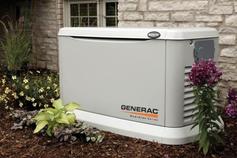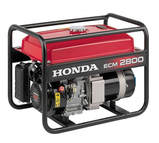|
Homeowners may use a generator to supply electricity to their home in the case of a power outage, either out of necessity or convenience. Inspectors may want to know about generators and the potential hazards they present when improperly wired or utilized. Generator Types There are two main types of generators: permanently installed, standby generators; and gasoline-powered, portable generators. Standby Generators Standby generators typically operate on natural gas or liquid propane. They remain fixed in place outside the home and are designed to supply on-site power to specified circuits through a home's electrical wiring. These generators work in tandem with a manual or automatic transfer switch, which automatically detects an interruption in grid-powered electricity and subsequently transfers over electrical input to the generator.
Some advantages of standby generators are as follows:
Gasoline-powered, portable generators are typically smaller in size and power capacity than permanently installed generators. They are designed so that corded electrical devices may be plugged directly into them. Advantages to portable generators are as follows:
Inspecting A Generator
InsideOut inspectors check for the following:
In summary, generators can be lifesavers during a power outage, but they present serious health and safety concerns if they are not installed and used properly.
1 Comment
3/30/2020 10:50:16 am
I like what you said about getting a standby generator since they can be turned on manually. My sister has been telling me about how she wants to make sure that her home always has power in the coming weeks. I'll share this information with her so that she can look into her options for generators who can help her with this.
Reply
Your comment will be posted after it is approved.
Leave a Reply. |
InsideOut Team
This blog is to help people better understand their home inspection. It is filled with great in depth advice. If you'd like a topic covered just send us an email on what you need more information on! Archives
August 2023
Categories
All
|
AboutThe best home & commercial building inspection company in Michigan. Serving Southeast Michigan, Northwest Ohio, Northern Michigan and surrounding areas.
|
Address8314 Whiteford Center Rd Ottawa Lake, MI
49267 1354 W Bear Lake Rd NE Kalkaska, MI 49646 |
ConnectSE Michigan: 734-224-0342
N Michigan : 231-714-6880 NW Ohio: 419-215-3856 [email protected] M-F: 7AM - 8:30 PM Saturday: 7AM - 8:30 PM Sunday: 7AM - 8:30 PM |
Social Media |
Resources |
© 2023 InsideoutInspections.net. All Rights Reserved.



 RSS Feed
RSS Feed